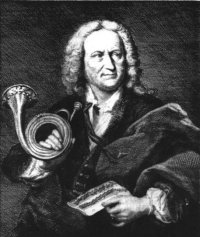
The trumpeter Gottfried Reiche (1667-1734)

Gottfried Reiche was born on Saturday, Feb. 5, 1667 at the court town Weissenfels. Weissenfels was known as a place with a long tradition of trumpet playing. Reiche stayed in this town until he was 21. Then, in 1688 he went to Leipzig. In Leipzig he became an assistant Stadtpfeifer. Reiche was promoted to Senior Stadtpfeifer in 1706. When the trumpeter Johann C. Genzmer died in 1719, Reiche became Senior Stadtmusicus.
The composer:
As with other Stadtpfeifers, and
in particular his earlier Leipzig predecessor, Pezel, Reiche was also a
composer of socalled "tower music" (Turmmusik). His only published work
is 24 Neu Qutricinia (1696) for Cornetto and 3 trombones.
Reiche
had also composed 122 Abblasen-Stücken, but only a single
Abblasen
has survived. It is depicted in the 1727 portrait of Reiche by
Leipzig artist E. G. Haussmann (see above).
How he died:
In Johann S. Riemer's Ms. Chronik preserved
in the Stadtarchiv, Leipzig, for Wednesday, Oct. 6, 1734, there
is
the following report:
"On precisely this day the highly skilled and most artistic musician and Stadtpfeifer, Herr Gottfried Reiche, the Leucopetra-Misnicus and senior member of the municipal company of musicians in this place, suffered a stroke as he was going home and dropped dead in the Stadtpfeifer-Allee not far from his house where he was taken. The reason for this was on account of the enormous strain he suffered the night before while blowing [the trumpet] for the royal music, his condition having been greatly aggravated from the smoke given off by the torch-lights."
The Brandenburg concerto:
In an article in Historic Brass Society
Journal, called "Bach, Reiche and the Leipzig collegia musica", Don
Smithers
says the following (page 30):
"We
may reasonably suppose that Reiche
did,
in fact, play the second Brandenburg concerto under Bach's direction
with
the collegium musicum at one or another of the venues where he is known
to have performed with that ensemble. Moreover, it is not beyond the
bounds
of reason to suppose that Christoph Ruhe, Reiche's successor, may have
played the same work with the same ensemble sometime after Reiche's
death
in October, 1734"